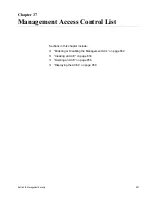
AT-S63 Management Software Menus User’s Guide
Section IX: Management Security
643
If you will be specifying more than one server and if all of
the servers use the same encryption secret, you can answer No to this
prompt and enter the encryption secret using the TAC Global Secret
parameter.
However, if you are specifying only one server or if the
servers have difference encryption secrets, then respond with Yes to
this prompt. You will see:
Enter per-server secret [max 40 characters] ->
Use this prompt to enter the encryption secret for the server
whose IP address you are specifying. The maximum length is 39
characters.
4 - TAC Global Secret
If all of the servers have the same encryption secret, rather
then entering the same secret when you enter the IP addresses, you
can use this option to enter the secret just once. The maximum length
is 39 characters.
5 - TAC Timeout
This parameter specifies the maximum amount of time the switch waits
for a response from a server before assuming the server is
not responding. If the timeout expires and the server has not
responded, the switch queries the next server in the list. If
there are no more servers, the switch defaults to the standard Manager
and Operator accounts. The default is 30 seconds. The range is 1 to
300 seconds.
5. After you have finished configuring the parameters in the
Client Configuration menu, type
R
to return to the Authentication
Configuration menu, shown in Figure 238 on page 640.
6. To activate the feature, perform the procedure “Enabling or Disabling
Server-based Management Authentication” on page 640.
Summary of Contents for AT-9400
Page 16: ...Figures 16 ...
Page 18: ...Tables 18 ...
Page 28: ...Preface 28 ...
Page 30: ...30 Section I Basic Operations ...
Page 60: ...Chapter 1 Basic Switch Parameters 60 Section I Basic Operations ...
Page 64: ...Chapter 2 Port Parameters 64 Section I Basic Operations Port Type The port type ...
Page 84: ...Chapter 2 Port Parameters 84 Section I Basic Operations ...
Page 124: ...Chapter 6 Static Port Trunks 124 Section I Basic Operations ...
Page 144: ...144 Section II Advanced Operations ...
Page 196: ...Chapter 10 File Downloads and Uploads 196 Section II Advanced Operations ...
Page 218: ...Chapter 11 Event Logs and the Syslog Client 218 Section II Advanced Operations ...
Page 242: ...Chapter 13 Access Control Lists 242 Section II Advanced Operations ...
Page 294: ...294 Section III IGMP Snooping MLD Snooping and RRP Snooping ...
Page 314: ...Chapter 19 MLD Snooping 314 Section III IGMP Snooping MLD Snooping and RRP Snooping ...
Page 318: ...318 Section IV SNMPv3 ...
Page 416: ...Chapter 21 SNMPv3 416 Section IV SNMPv3 ...
Page 418: ...418 Section V Spanning Tree Protocols ...
Page 470: ...470 Section VI Virtual LANs ...
Page 520: ...Chapter 26 Multiple VLAN Modes 520 Section VI Virtual LANs ...
Page 532: ...Chapter 27 Protected Ports VLANs 532 Section VI Virtual LANs ...
Page 546: ...546 Section VII Internet Protocol Routing ...
Page 560: ...560 Section VIII Port Security ...
Page 568: ...Chapter 30 MAC Address based Port Security 568 Section VIII Port Security ...
Page 586: ...Chapter 31 802 1x Port based Network Access Control 586 Section VIII Port Security ...
Page 588: ...588 Section IX Management Security ...
Page 610: ...Chapter 33 Encryption Keys 610 Section IX Management Security ...
Page 650: ...Chapter 36 TACACS and RADIUS Protocols 650 Section IX Management Security ...
Page 660: ...Chapter 37 Management Access Control List 660 Section IX Management Security ...
Page 668: ...Index 668 ...
















































